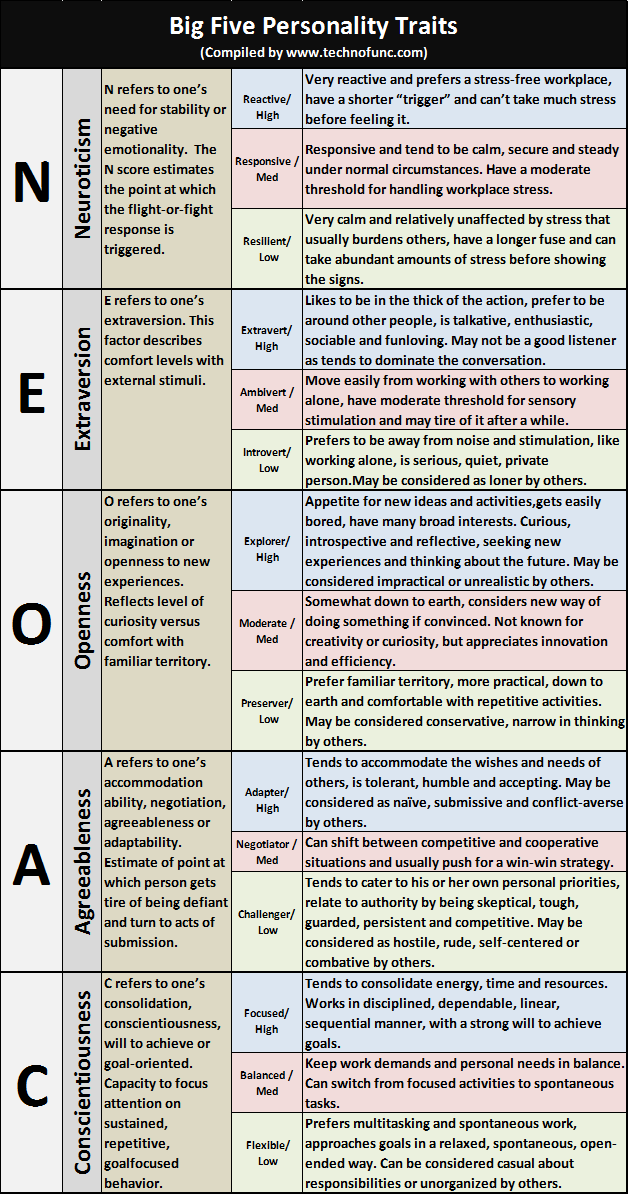- Home
- Business Processes
- Industry Knowledge
- Aerospace Industry
- Automotive Industry
- Banking Domain
- BFSI Industry
- Consumer/ FMCG Industry
- Chemicals Industry
- Engineering & Construction
- Energy Industry
- Education Domain
- Finance Domain
- Hospitality Domain
- Healthcare Industry
- Insurance Domain
- Retail Industry
- Travel and Tourism Domain
- Telecom Industry
- Leadership Skills
- eLearning
- Home
- Leadership
- Leadership Theories
- Five-Factor Personality Model
Five-Factor Personality Model
Five Factors Model (FFM) also known as Five-Factor Personality Model is based on five broad personality traits which are extraversion, neuroticism, openness to experience, agreeableness, and conscientiousness represented by acronym OCEAN, these traits are often referred to as the “Big Five”.
What are Big Five Personality Traits:
Over the past 25 years, a consensus has emerged among researchers regarding the basic factors that make up what we call personality. Psychologists now believe that of all the various methods for classifying personality dimensions, only one stands out as the most statistically robust: the Big Five. These factors, commonly called the Big Five, are neuroticism, extraversion, openness, agreeableness and conscientiousness.
N = Neuroticism = Need for stability, negative emotionality
E = Extraversion = Positive emotionality, sociability
O = Openness = Originality, imagination
A = Agreeableness = Accommodation, adaptability
C = Conscientiousness = Consolidation, will to achieve, goal-oriented
Table below provides the description, attributes and explanations for each of the factors listed above. These five personality factors are the most reliable for differentiating personality traits. The Big Five synonym clusters appear to account for most differences among individual personalities, describing five universal dimensions. We score a high, low or mid-range rating in each dimension and interpretations of the scores is given below:
|
Big Five Personality Traits |
||||
|
N |
Neuroticism |
N refers to one’s need for stability or negative emotionality. The N score estimates the point at which the flight-or-fight response is triggered. |
|
Very reactive and prefers a stress-free workplace, have a shorter “trigger” and can’t take much stress before feeling it. |
|
Responsive / |
Responsive and tend to be calm, secure and steady under normal circumstances. Have a moderate threshold for handling workplace stress. |
|||
|
Resilient/ |
Very calm and relatively unaffected by stress that usually burdens others, have a longer fuse and can take abundant amounts of stress before showing the signs. |
|||
|
E |
Extraversion |
E refers to one’s extraversion. This factor describes comfort levels with external stimuli. |
|
Likes to be in the thick of the action, prefer to be around other people, is talkative, enthusiastic, sociable and funloving. May not be a good listener as tends to dominate the conversation. |
|
Ambivert / |
Move easily from working with others to working alone, have moderate threshold for sensory stimulation and may tire of it after a while. |
|||
|
Introvert/ |
Prefers to be away from noise and stimulation, like working alone, is serious, quiet, private person.May be considered as loner by others. |
|||
|
O |
Openness |
O refers to one’s originality, imagination or openness to new experiences. Reflects level of curiosity versus comfort with familiar territory. |
|
Appetite for new ideas and activities,gets easily bored, have many broad interests. Curious, introspective and reflective, seeking new experiences and thinking about the future. May be considered impractical or unrealistic by others. |
|
Moderate / |
Somewhat down to earth, considers new way of doing something if convinced. Not known for creativity or curiosity, but appreciates innovation and efficiency. |
|||
|
Preserver/ |
Prefer familiar territory, more practical, down to earth and comfortable with repetitive activities. May be considered conservative, narrow in thinking by others. |
|||
|
A |
Agreeableness |
A refers to one’s accommodation ability, negotiation, agreeableness or adaptability. Estimate of point at which person gets tire of being defiant and turn to acts of submission. |
|
Tends to accommodate the wishes and needs of others, is tolerant, humble and accepting. May be considered as naïve, submissive and conflict-averse by others. |
|
Negotiator / |
Can shift between competitive and cooperative situations and usually push for a win-win strategy. |
|||
|
Challenger/ |
Tends to cater to his or her own personal priorities, relate to authority by being skeptical, tough, guarded, persistent and competitive. May be considered as hostile, rude, self-centered or combative by others. |
|||
|
C |
Conscientiousness |
C refers to one’s consolidation, conscientiousness, will to achieve or goal-oriented. Capacity to focus attention on sustained, repetitive, goalfocused behavior. |
|
Tends to consolidate energy, time and resources. Works in disciplined, dependable, linear, sequential manner, with a strong will to achieve goals. |
|
Balanced / |
Keep work demands and personal needs in balance. Can switch from focused activities to spontaneous tasks. |
|||
|
Flexible/ |
Prefers multitasking and spontaneous work, approaches goals in a relaxed, spontaneous, open-ended way. Can be considered casual about responsibilities or unorganized by others. |
|||
Study to Examine Big Five Personality Dimensions:
To assess the links between the Big Five and leadership, Judge, Bono, Ilies, and Gerhardt (2002) conducted a major meta-analysis of 78 leadership and personality studies and found a strong relationship between the Big Five traits and leadership.
This model of leadership was result of a study to examine the relationship between the “Big Five” personality dimensions (neuroticism, conscientiousness, extraversion, agreeableness, and openness) with respect to career success. A sample of few hundred employees was surveyed in a diverse set of occupations and organizations. Hierarchical regression analysis was used to examine the incremental variance contributed by the five personality traits after controlling for several career-related variables.
Results showed that, extraversion was related positively to salary level, promotions, and career satisfaction and that neuroticism was related negatively to career satisfaction. Agreeableness was related negatively only to career satisfaction and openness was related negatively to salary level. It was confirmed as expected that having certain personality traits is associated with being an effective leader.
Is the Big Five personality assessment valid?
Researchers have pointed to reliability studies that are consistent enough to approach the status of law and for the corporate world; this model provides a reliable, standard vocabulary with which to discuss personality differences. Although the Big Five model gives us a uniform language based on standard definitions, but the fact remains that a combination of forces shape an individual. The Five Factors can be thought as being the main infrastructure as human individuality is too complex for any one system to explain adequately.
This personality assessment can be practically applied to identify the needs of a specific role prior to selecting or appointing a leader and performing a match of factors to determine success of the individual in the role.

Related Links
You May Also Like
-
The Vroom-Yetton model is designed to optimize for the current situation the leadership style for best decision-making. Its a decision model formulated with contribution from Arthur Jago on how to make group decisions. The leader must gather information from the team prior to making the decision and involves more people in the decision process.
-
The social identity theory of leadership views leadership as a group process. Social identity is a person's sense of who they are based on their group membership. Social identity theory sets agendas and goals generated by social categorization, defines who we are based on processes associated with social identity, and motivates to conduct ourselves based on what followers think of the leader.
-
Participative Leadership Theories
Participative leadership theories rely on the involvement of different participants and suggest that the ideal leadership style is one that takes the inputs of others into account. Participative leaders encourage participation and contributions from group members and involve them in the decision-making process. Participative leadership tries to achieve through people, teamwork and collaboration.
-
Transactional Theory of Leadership
Transactional leadership theory is based on the concept of rewards and punishments. The transactional management approach assumes that the desires of the leader and follower are different and leaders give followers something in exchange for getting something they want. Transactional leaders expect followers to be compliant and focuses on structure, instruction, monitoring, organization, or performance to get tasks completed on time.
-
Continuum of leadership is a leadership theory based on the relationship between the level of freedom given to the team and the level of authority used by the manager. The chosen leadership style will depend on multiple factors, including the leader's personality.
-
Team leadership theory is a recent leadership theory that does not discriminate between the leader and the other team members. The approach considers contributions from each team member to be critical for organizational success. This approach focused on the overall team effectiveness and team problems are diagnosed and action is taken to remediate weakness. This approach provides for taking corrective action when the leader deems necessary.
-
Contingency Theories of Leadership
Contingency theories of leadership focus on both the leader's persona as well as the situation/environment in which that leader operates. These theories consider the context of leadership which means whether or not the leadership style suits a particular situation and states that a leader can be effective in one circumstance and a failure in another one. A leader will be most effective when he applies the right leadership style to a given situation and environment around him. Contingent leaders are flexible and adaptable.
-
Reciprocal influence theory also known as reciprocal determinism is authored by Albert Bandura and states that an individual's behavior influences and is influenced by both the social world and personal characteristics. Three factors that influence behavior are the environment, the individual, and the behavior itself. Certain leader behaviors can cause subordinate behaviors and reciprocal influence on the leader by the group.
-
Self-Fulfilling Prophecy (SFP) Leader Theory
Pygmalion theory of Leadership is a model of SFP at work involving supervisory expectancy based on the pygmalion effect. This effect is a type of self-fulfilling prophecy (SFP) in which raising leader's expectations regarding subordinate performance boosts the group's performance. Managers who are led to demand more from their team, lead the team to better performance. There is some evidence that the SFP effect does exists.
-
Situational Leadership - Application
Situational Leadership Theories are well known and frequently used for training leaders within organizations. Practical application is how to choose the right leadership approach for the situation. The theory emphasizes leader flexibility and advises leaders to flex their style based on the followers' needs. Leaders must adapt their leadership style to fit the prescribed task, understanding given situation/maturity of followers.
Explore Our Free Training Articles or
Sign Up to Start With Our eLearning Courses

About Us
Learning
© 2023 TechnoFunc, All Rights Reserved










